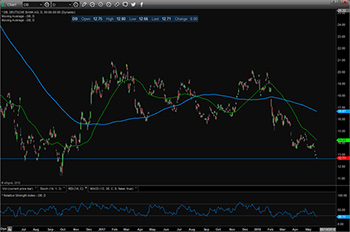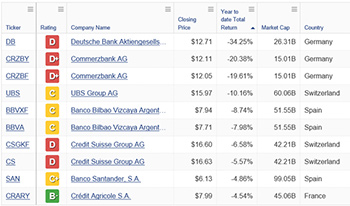It’s been raining for days here in South Florida. Many, many days. Heck, I half expect to wake up and see an ark floating past our house soon.
So, maybe it’s not surprising I’m thinking of rot. Wet, stinky, yet also hard-to-see-and-find rot. It can build up for months, even years, behind your walls — and the cost of locating and repairing the problem can be substantial.
Why bring this up in a column about the markets? Because as I explained on my Twitter account Friday (You can follow me at @RealMikeLarson), there’s a lot going on “behind the drywall” in stocks, too!
Consider our old friends the European mega-banks. These behemoths were grabbing headlines a few years ago because their shares were collapsing amid surging debt default risk. Then the European Central Bank fired off its monetary “bazooka,” promising to buy any and all European bonds that weren’t nailed down.
We were told that “fixed” the problem. But guess what? Many of those very same bank stocks are tanking again!
Take a look at this chart of Deutsche Bank (DB, Rated “D”), the biggest bank in the biggest economy in Europe, Germany. Its U.S.-traded American Depository Receipts have plunged more than 34% year-to-date amid large-scale layoffs, a 79% plunge in Q1 profit, and the ship-jumping by several executives.
But DB is far from alone. That’s because the same European debt problems that the ECB tried to paper over are resurfacing again.
A key reason: Two anti-establishment, popular political parties called the Five Star Movement and the League have now solidified their hold on power in Italy.
Leaders are pushing big tax cuts and a surge in social spending. They’ve even discussed asking the ECB to write off most of the 341 billion euros in Italian debt it holds.
That would spark massive dislocations in the European bond market, not to mention carry untold consequences for the euro currency bloc. After all, Italy currently owes about 2.26 trillion euros in government debt. That puts its debt-to-GDP ratio at a whopping 132% — second only to Greece in the eurozone!
No wonder Italian government bond yields are starting to spike higher … and European bank shares are starting to fall … again.
Take a look at this European Financial Stock Screener I created, and you’ll see what I mean. Many of Europe’s biggest banks trade here in the U.S. as American Depository Receipts, and they’re massively underperforming the market.
You can see DB is the worst offender, but right behind it is another German mega-bank Commerzbank AG (CRZBY). Its main ADRs are down more than 20% so far this year. UBS Group (UBS) of Switzerland has dropped more than 10%, while Banco Bilbao Vizcaya Argentaria (BBVA) of Spain is off around 8%.
We’re not talking about rinky-dink companies, either. Just look at the market caps of these mega-banks: $26.3 billion for DB, $15 billion for CRZBY, $60.6 billion for UBS, and $51.6 billion for BBVA. This ongoing tumult is definitely something to keep an eye on.
And European banks aren’t the only stocks getting hammered. As I wrote recently, the rising U.S. dollar is causing all kinds of headaches for foreign companies and countries outside of Europe, too. The Wall Street Journal recapped some of the fallout on Monday, saying:
“Indonesia’s central bank on Thursday raised interest rates for the first time in four years to arrest a drop in its currency; Hong Kong’s monetary authorities last week stepped in to prop up the territory’s weakening dollar. The Turkish lira fell to fresh lows against the U.S. dollar, while Brazil’s real declined to its weakest level in more than two years.”
What’s the result? If you sort the roughly 1,900 ETFs we track at Weiss Ratings by worst 1-month total returns, you get a whole host of foreign-focused and emerging market funds on the list.
Ever since we launched our Weiss Cryptocurrency Ratings in January, the crypto world has been asking us to reveal to the public our ratings for each of the 93 cryptocurrencies we cover. And on Tuesday, May 29, we will do just that, PLUS show the inner components of each of those ratings. If you don’t want to wait, you can accept our special membership offer now and be among the very first in the world to receive this new, critical information. And as a member, you’ll not only get a clear perspective on WHY each crypto merits its Weiss Cryptocurrency Ratings, but also get tools for using them in practice.
The iShares MSCI Turkey ETF (TUR, Rated “C-”) has tanked 17.2% in just the last 30 days, while the iShares MSCI Brazil Small-Cap ETF (EWZS, Rated “C+”) has dropped 16.6%. The iShares MSCI Mexico Capped ETF (EWW, Rated “C-”) is off 14.2% and the iShares MSCI Indonesia ETF (EIDO, Rated “C”) is down 13.3%.
I could also point to other signs of trouble behind the wall. Take the fact that the yield difference, or spread, between corporate bonds and Treasuries is starting to rise notably. That’s a sign of increasing credit concerns. In fact, the combination of rising spreads and falling debt prices just handed corporate bond investors the third-worst stretch of 100-day returns since 2000, according to Bloomberg.
Then you have the ongoing collapse in the Treasury yield curve to its flattest level since 2007 — and a Federal Reserve that’s on track to keep hiking short-term rates for the rest of 2018 and beyond. The flatter the curve, and the more aggressive the hikes, the greater the likelihood my “Everything Bust” scenario comes to pass. In fact, analysts at Citigroup just warned of the potential for a “structural re-pricing of asset markets” akin to what happened in the credit crisis.
None of that kept the Dow Industrials from mounting a 1,500-point oversold rally off its early-May low. But it does underscore why I remain cautious on this market. It’s also why I continue to recommend you start hedging against downside risks, and keep much higher cash levels on hand that you have over the past few years.
You definitely want to own some gold and gold mining stocks as “chaos insurance,” too. If the stock market does crack wide open, and the emerging market and European turmoil gets worse, you’re going to be thankful you have some protection against the surge in volatility that will accompany it.
Oh, and if you haven’t done so already, take advantage of this bounce to unload the dead weight in your portfolio. By that, I mean do what I recommended in March and April: Use our Weiss Ratings to identify vulnerable, SELL-rated stocks you might be holding and get rid of ‘em!
Until next time,
Mike Larson



